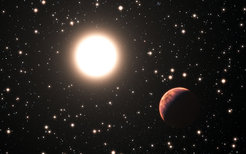First Planet Found Around Solar Twin in Star Cluster
MPE astronomers have used ESO's HARPS planet hunter in Chile, along with other telescopes around the world, to discover three planets orbiting stars in the cluster Messier 67. Although more than one thousand planets outside the Solar System are now confirmed, only a handful have been found in star clusters. Remarkably one of these new exoplanets is orbiting a star that is a rare solar twin — a star that is almost identical to the Sun in all respects.

Planets orbiting stars outside the Solar System are now known to be very common. These exoplanets have been found orbiting stars of widely varied ages and chemical compositions and are scattered across the sky. But, up to now, very few planets have been found inside star clusters. This is particularly odd as it is known that most stars are born in such clusters. Astronomers have wondered if there might be something different about planet formation in star clusters to explain this strange paucity.
Anna Brucalassi (Max Planck Institute for Extraterrestrial Physics, Garching, Germany), lead author of the new study, and her team wanted to find out more. “In the Messier 67 star cluster the stars are all about the same age and composition as the Sun. This makes it a perfect laboratory to study how many planets form in such a crowded environment, and whether they form mostly around more massive or less massive stars.”
The team used the HARPS planet-finding instrument of ESO and supplemented their results with observations from several other observatories around the world. They carefully monitored 88 selected stars in Messier 67 over a period of six years to look for the tiny telltale motions of the stars towards and away from Earth that reveal the presence of orbiting planets.
They found three planets, two orbiting stars similar to the Sun and one orbiting a more massive and evolved red giant star. The first two planets both have about one third the mass of Jupiter and orbit their host stars in seven and five days respectively. The third planet takes 122 days to orbit its host and is more massive than Jupiter.
The first of these planets proved to be orbiting a remarkable star — it is one of the most similar solar twins identified so far and is almost identical to the Sun. It is the first solar twin in a cluster that has been found to have a planet.












